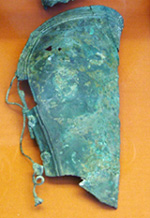 |
The Greek Age of Bronze
Greaves and Arm guards |
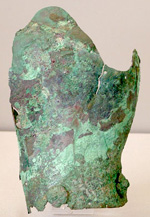 |
The use of greaves or lower legs protections is well attested in the Late Helladic period both for findings and artistic representations. In some cases the presence of metallic greaves seem strictly related to the use of defence weaponry like armour and corselet.
Very few evidences have been found about the use of arm guards or wrist protections during the Late Helladic period, indeed some rare findings attest their actually utilization. The lacking of findings and the absence in the Iliad description (*1) it is a indication of their limited use. Probably the use of arm guards in this period was less common than generally believed. |
| GREAVES AND LEG PROTECTIONS
|
| The earliest evidences of elements which probably served both for fastening and ornamenting the greaves are from the circle A tombs IV, V and VI dated between LH I and LH II (around 1550-1500 BC) and from circle B tomb iota dated from the beginning of the sixteenth century BC in Mycenae. |
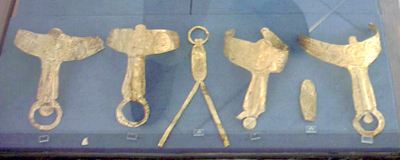 |
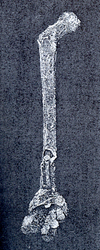 |
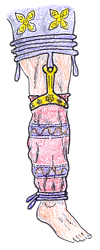 |
These gold elements were composed by a band consists of two parts, the lower horizontal and the upper vertical; the former being attached by a fine gold wire, the latter by means of the ring which was located at its extremity and which must have been fastened to a button fixed to the short trousers.
Even if for some scholars the interpretation of these elements as greaves fastening is still questionable, their location around the human thigh-bone attested in some of the sepulchres support this theory. |
| Warriors wearing short trousers are well represented in some rings, seals and weapons decorations found in the same sepulchres in Mycenae cirle A tombs as well as in the seal-stone from Thisbe part of the controversial "treasure of seals"(*2) dated around 1500 BC. |
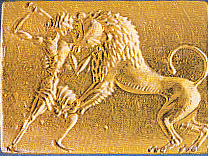 |
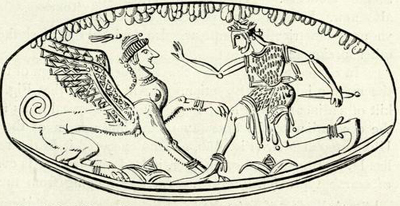 |
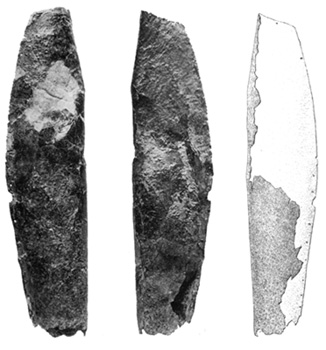 |
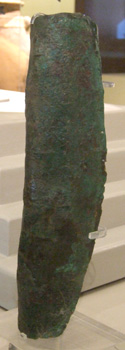 |
The early true bronze greaves have been found together the armour in the tomb n. 12 of Dendra dated between LH II and LH IIB (1450-1400 BC). One of these greaves is almost complete while the other is very fragmentary. One side of the reconstructed greave is almost complete as well as a small upper piece on the other side with a strip along the curve over the shin bone. On the reassembled side the old edge has been preserved at the top and at the side. But a lot is missing at the top and therefore we don't know if the greave stopped just below the knee or it was extended to form a kind of knee-plate. The latter is the more probable.
The bronze is about as thin as piece of paper and there are a series of small holes along the side. At some holes even traces of thongs have been found which indicates that the holes enabled a lining to be attached. The Dendra greaves were held to the warrior's legs only by elasticity of the metal, even if an additional fastening by means of thongs placed below the knees and around the ankles can't be excluded. |
| Another type of bronze grave has been found in a chamber tomb in Enkomi Cyprus dated around 1200 BC. This specimen shows metal rings on the edge which was holding the thongs used for the greave fixation . |
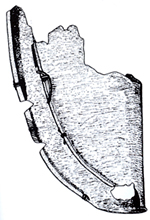 |
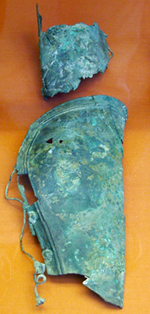 |
Always from Enkomi are two other greaves dated right after the 1200 BC. These show some differency to each other so more likely are elements of two different set.
The best preserved one is decorated with circles of small bosses, and on the edge a metal wire for thongs fixation is placed. The other one is plain without decorations with the metal ring for thongs fastening directly applied on the greave edge. |
| A remarkable pair of bronze greaves are from the warrior grave A in Kallithea dated about LH IIIC found together the metal strips of a tiara like helmet (see late helmet page). These greaves are fully decorated with lines and circles of small bosses. metal wire are placed on the edges for thongs fastening. Their dimension are 255 mm long and 126 mm large. |
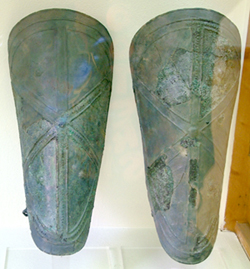 |
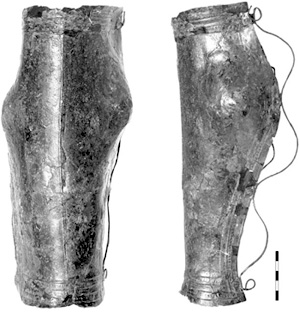 |
A pair of bronze greaves have been also found in a grave dated LH IIIC excavated in the tomb 1 at Kouvaras near the town of Amphilochia. The Greaves have been found together a bronze sword with gold-wired wrapped around the hilt imported from the Italian peninsula, a bronze sword with bone handle, a bronze and iron dagger, an arrowhead, a spear point, a golden wine cup and a bronze boiler. |
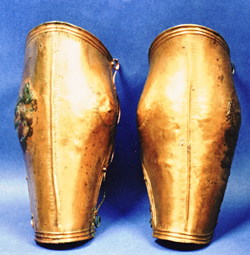 |
Another pair of similar greaves have been found in the tomb 3 at Portes-Kephalovryso dated around 1200-1100 BC near the border between Achaia and Elis. The greaves have ben found together a Naue II sword, a spearhead, dagger and bronze bands part of a "tiara-like" headgear. (Moschos) |
| Very interesting greaves decorated with several circles of small bosses are from a chamber tomb dated around 1100-1000 BC excavated in the south slope of the Athens Acropolis. |
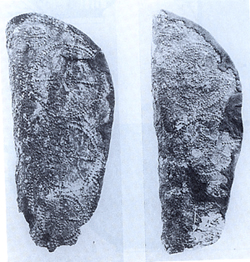 |
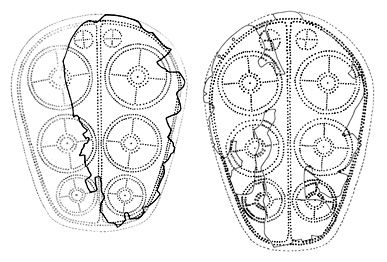 |
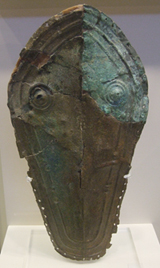 |
Similar greaves were also used in Greece and in the rest of the Europe also during the early Iron Age as well attested by this beautiful specimen exposed in the Olimpia Archaeological museum. |
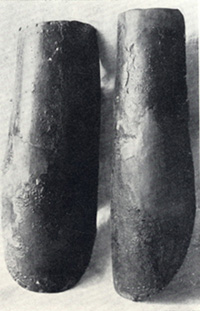 |
Other very interesting greaves have been found in the Geometric tomb of Skouriasmenos in Kavousi. These greaves have decorated edges with small shells showing closer similarity with Bronze Age style. |
A strange and unique bronze element (found together armour band sheets, see the page dedicated to the armour) from Mycenae chamber tomb 15 dated LH IIIA/B1 (1300-1250 BC) has been interpreted by Yaluris as a protection for the ankle (the same element has been later also interpreted as hand protection, see the bellow section dedicated to the arm guard).
The element shows small holes around the edge enabled a lining to be attached and two buttons for thongs fixation. The utilization of ankles protection seems also attested in the Iliad (*3) |
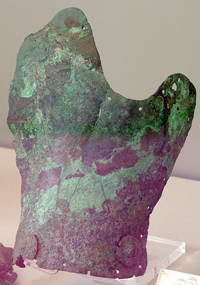 |
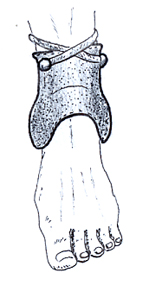 |
| Despite the few elements survived the utilization of greaves in the Aegean Age of Bronze is fully attested on pictorial representation both on fresco and on pottery as well as in the Iliad (*4). |
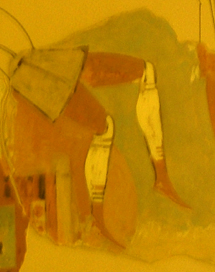 |
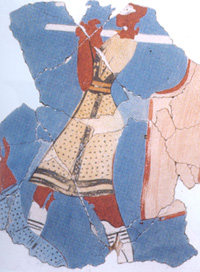 |
On a fresco from the "Megaron" in Mycenae a warrior is wearing long white greaves with knee protections. The same type of greaves are also depicted in other frescos found in the "House of the oil merchant" and in the palace from Mycenae. All these representation show strings (red, dark brown and black) under the knees and around the ankles probably leather strips used to secure the greaves. All these representation are dated between LH IIIA and LH IIIB (1370-1350 BC) |
| Because their white colour these protections were probably made of linen even if the possibility of metallic greaves in bronze or tin similar to the one found in the Dendra tomb can't be excluded. |
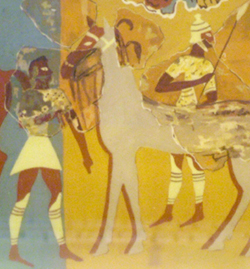 |
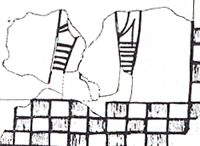 |
From the palace of Orchomenos a small fragment of fresco dated between LH IIIA and LH IIIB shows the lower part of a warrior greaves with strings and an elliptical line. |
| Similar leg protections are well represented in several frescos from Pylos dated around 1300 BC. In some of these paintings the greaves fastening system is also evidenced being the free ends of fastening thongs sometimes visible. |
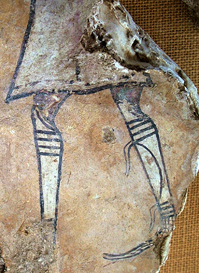 |
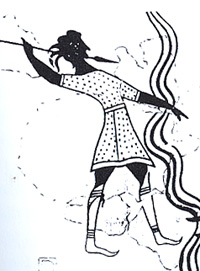 |
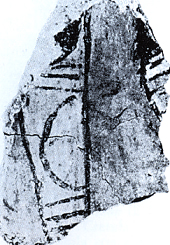 |
Mostly of these greaves show an elliptical line painted on one leg only. It could be the representation of a singular metal greaves similar to the ones found in Kallithea, Athens or Enkomy placed over the linen protection, or more simply the folded end of the linen graves only visible in the internal or external side of the legs. |
| The representation of a greave is also visible on a beautiful fresco fragment dated 14th century BC from the site of Aghios Vassilios hill near the village of Xirokambi in Laconia. |
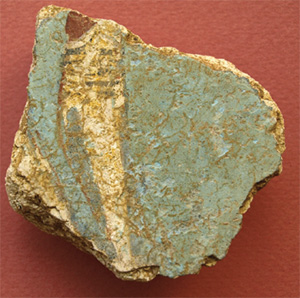 |
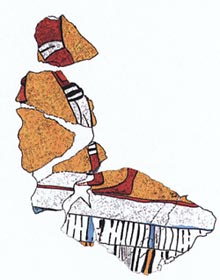 |
The representation of a similar greave is also visible on a fresco fragment dated LH IIIB1 from the boar hunt scene in the Palace of Orchomenos.
a kind of upper leg protection seems also worn by the warrior. |
| During the LH IIIC period another type of greaves are also attested. These were normally represented shorter without the rigid knee protections and in dark colour. Fastening strips or cloth bands for legs protections are normally visible over the knees and around the ankles. |
| Typical example of such greaves are shown in the warrior vase and stele from Mycenae. These leg protections are generally interpreted as made of leather, but also in this case we can't exclude the possibility of bronze greaves worn over a cloth stockings or bands. |
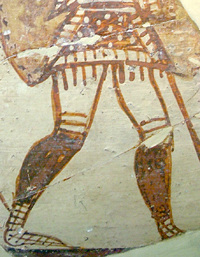 |
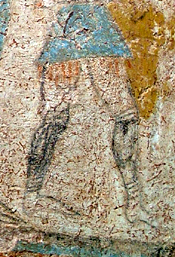 |
| Similar greaves are well depicted in several pottery from Mycenae, Tyrins, Leukandi and Ugarit, in some cases the fastening thongs are also visible. |
| CENTRAL EUROPE GREAVES
|
| From the rest of Europe worthy to be mentioned are some greaves dated around 1000 BC found in Hungary, Moravia, Austria, Bosnia and Kroatia because their vicinity with the Greece mainland and because their similarity with the late Achaean specimens.The intensive commercial trade between the Aegean world and the central Europe is mainly attested between the 1550-1450 BC, thus during the changing phase of the Achaean defensive equipments. This support the idea about the passage of some of the typical Aegean defences, like for instance the greaves, to the central Europe areas. By other hands the decorated specimens could have been influenced by central Europe fashion moved in the Greece mainland at the end of the Bronze Age.
|
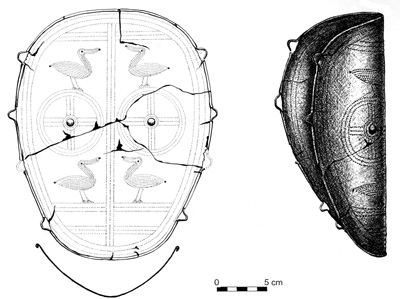 |
a)At the site of Rinyaszentkiràly in Hungary we have an example of graves that had been decorated with water-birds; a recurring theme of he later Bronze Age, perhaps connected to the importance of water in the votive practices of the age. |
| b)In a late Bronze Age burial mound at Ilijak and Glasinac in Bosnia a series of greaves bearing ornate decoration have been found. In a couple of these greaves the decoration include a depiction of a deer and a ship. |
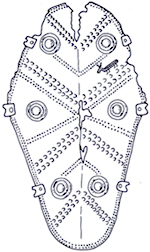 |
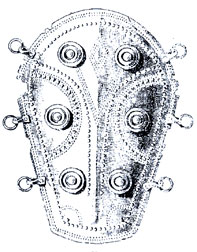 |
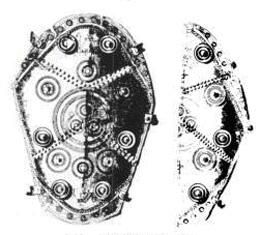 |
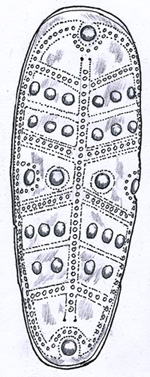 |
c)Another remarkable example of central Europe bronze greave is from Kurim Moravia. Also in this case the shape and the decorative motif show similarity with the late Bronze Age specimens found in Greece mainland. |
| d)A bronze greave, with circular decorations similar to the specimens found in Athens, is from Stetten in lower Austria . |
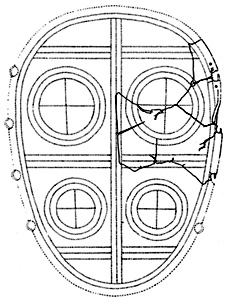 |
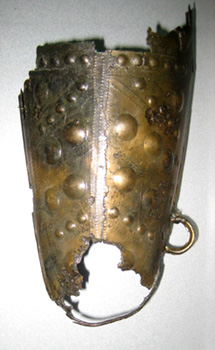 |
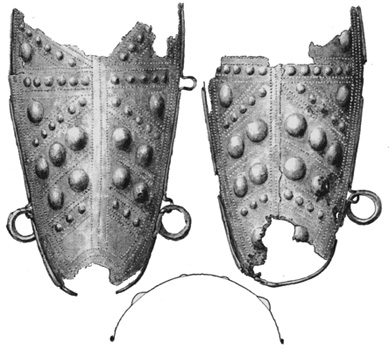 |
e)Another beautiful example of central Europe bronze greaves are from Klostar Ivanic Kroatia. Also in this case the embossed motif remaind similar decoration used in Late Helladic elements. |
| CONCLUSION
|
Based on the findings and art representations the use of greaves or leg protectons is attested since the beginning of the Late Helladic period. These protective elements seem to be specifically developed in the Achaean world, in fact no similar protections have been found neither in the near Easter nor in the central Europe during the early phase of the late Bronze Age. Their utilization on different areas than the Greece mainland is thus a further proof of the intensive commercial trade between the Achaeans and the surrounding populations both in the central Europe than in the central/eastern Mediterranean as well as Anatolian coast.
The findings in Dendra, Kallithea and some pottery representation attested how the greaves were sometimes strictly related to the use of a complete defence as armour or corselet, even if their utilization with simple "Kiton" or other outfit during cerimony or hunting activities is also documented. Appart of the few bronze specimens found in some tombs mostly of the greaves represented in the fresco or pottery were probably made of linen, leather or other perishable material being the elaborate metallic ones restricted to the high/medium rank warriors. It is thus undubfull that the greaves are an ancient tratitional defence of the Achaean weaponry and the lacks in the Linear B tablets description is probably only due to casuality because of the few survived script.
|
| The beautiful gold bracelet from circle A tombs IV in Mycenae dated between LH I and LH II (around 1550-1500 BC) even if it can't be considered a true arm protection, it is an interesting example of Achaean goldsmith production. |
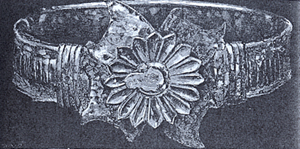 |
| Another splendidly ornamented gold ribbon has been also found on the upper arm bone of the warrior buried in the shaft-grave V in Mycenae dated LH II (around 1500 BC). Also in this case even if this object is inteded to be decorative it is worthy to be mentioned because its unicity . |
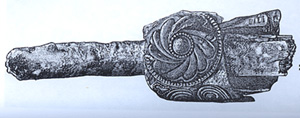 |
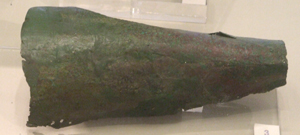 |
A bronze lower arm guard has been found together the armour and graves in the Dendra tomb n 12. This guard is shaped like a pipe and tapers towards the bottom. small holes enabled a lining to be attached are present all around the edge. The bronze is as thin as the greaves. The arm guard is 205 mm long with a diameter of 90 mm at the top and 40 mm at the bottom. |
| A unique and interesting element dated LH IIIA/B1 (about 1370- 1300 BC). comes from the Kadmeia, the Achaean citadel of Thebes in Boeotia. It seems to be a bronze war bracelet fully decorated with shells. Because of the very fine decorative motif this elements was more likely part of a high rank warrior's weaponry. This element has been also indicated as a piece from a bronze cauldron or vessel, but because its decoration design the identification as a warrior's bracelet seems more reasonable. |
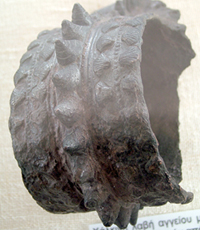 |
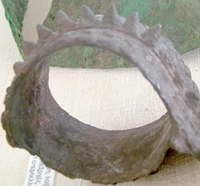 |
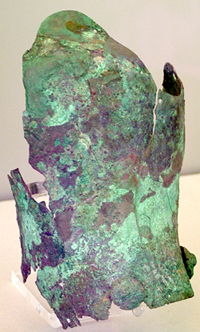 |
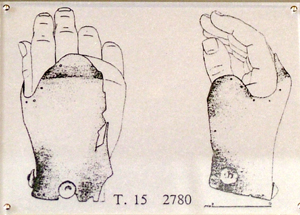 |
The strange and unique bronze element, above mentioned and interpreted by Yaluris as a protection for the ankle, from Mycenae chamber tomb 15 dated LH IIIA/B1 (1300-1250 BC) was later also interpreted as hand protection.
The element shows small holes around the edge enabled a lining to be attached and two buttons for thongs fixation. |
| A possible bronze lower arm protection dated about 1300 BC has been also found in the shipwreck excavation at Uluburun near Kas in the southern Turkey coast. |
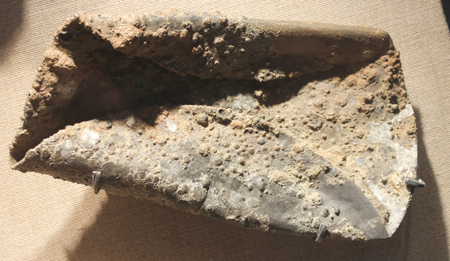 |
| Possible evidence of arm protections on art representation are respectively from a pottery fragment from Mycenae and a painting from Tiryns both dated LH IIIC. In both the fonts The warriors arms are marked with bands probably representation of a kind of protections which cold have been made of small bronze strips. |
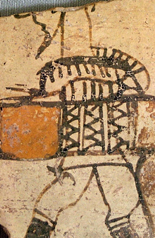 |
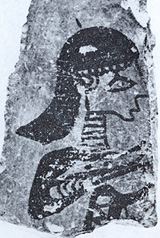 |
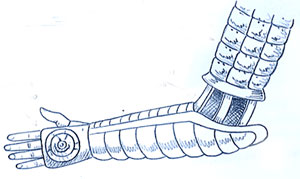 |
Similar arm protections are also represented in some bronze statuettes of fully equipped warriors found in Italian island of Sardinia dated around IX century BC.
The reconstruction drawing based on a bronze Sardinian statuette is by Angela Demontis (*5) |
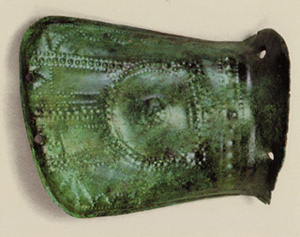 |
A probable hand guard of a left-handed warrior from the Urnfield culture in Central Europe belong to Guttmann collection. This element of unknow provenience and datation show closer similarity with some hand protection represented in the above mentioned Sardinian statuette. |
| worthy to be mentioned is also this bronze spiral armlet which has been found outside, but in the vicinity, of the Greek mainland. The specimen is from Halstatt Austria dated 13th to 12th Century BC. Even if it can't be considered a real arm protection it is indeed a remarkable arms related object. The spiral is formed of one continuous strip with central midrib coiled into six loops Jade-like patina.
. |
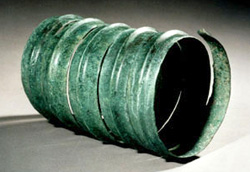 |
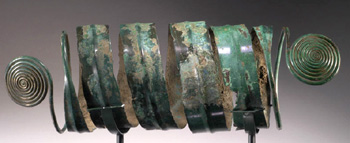 |
This specimen is another Middle European bronze spiralled wrisband dated around 1000 BC. The object is compoused by spiralled wristband in five turns made of wide bands ridged in the middle, petering out to round cross sections and ending in decorative spirales. The viewing side decorated with dots.
|
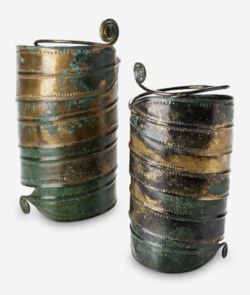 |
Similar specimens also dated around 1000 BC have been found in Central Europe probably in Austria.
|
| Other very interesting bronze spiral armlet found in Germany dated around 1250 BC.Also in this case The spirals design show similarity with other representation of Aegean elements and art.
|
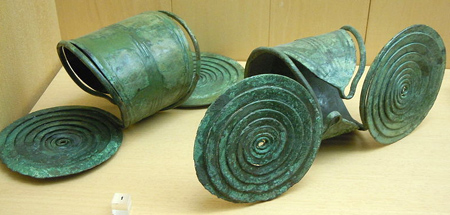 |
| CONCLUSION
|
| The very few evidences about the use of arm guards or wrist protections during the Late Helladic period it is a possible indication of their limited use. The lacking in findings and the rare mention of the arm-guard give a strong sign that the utilization of such protections in this period was less common than generally believed. Indeed the specimen from Dendra and the art representations clearly show how this defensive elements was well known in the Bronze Age Aegean world.
|
(*5)ANGELA DEMONTIS Il Popolo di Bronzo (abiti, armi e attrezzature dei bonzetti sardi in 100 schede illustrate) Condaghes 2006.
|
|